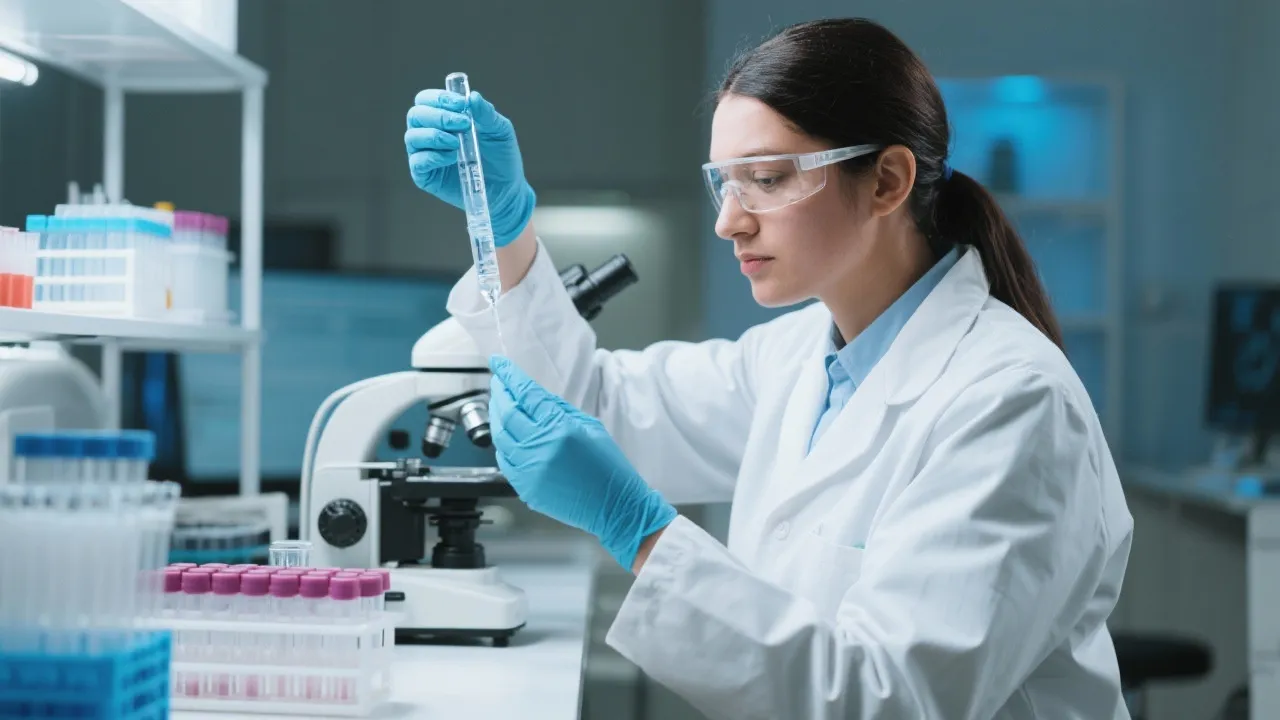Understanding Cyp1a1 Assay Techniques
This article delves into the significance of Cyp1a1 assays in pharmacology and toxicology. Cyp1a1, or cytochrome P450 1A1, plays a crucial role in metabolizing xenobiotics in the body. Assessing Cyp1a1 activity is vital for understanding drug interactions and environmental toxin impacts, using said assays as a key tool for researchers.

The Importance of Cyp1a1 in Biochemical Research
Cytochrome P450 1A1, often abbreviated as Cyp1a1, is an enzyme belonging to the larger cytochrome P450 family. This enzyme is primarily involved in the metabolism of xenobiotics, which include drugs and carcinogenic compounds found in the environment. As a member of the cytochrome P450 family, which comprises a vast array of enzymes with diverse functions, Cyp1a1 serves a critical role in biochemistry, especially concerning pharmacokinetics and toxicokinetics. Understanding the activity of Cyp1a1 is crucial for fields such as pharmacology and toxicology, where researchers seek to determine how substances are metabolized by the human body. Notably, the enzyme’s role extends beyond simple detoxification; it is also implicated in the bioactivation of pro-carcinogens, making its study vital in cancer research.
The interplay between various environmental factors and the Cyp1a1 enzyme offers a rich field for exploration, particularly in understanding susceptibility to diseases that may arise from exposure to pollutants and dietary substances. For instance, certain dietary components may influence Cyp1a1 activity, thereby modulating the effectiveness of drug therapies or the risk associated with exposure to environmental toxins. Investigating these aspects can help create a comprehensive view of how genetic and environmental factors converge, influencing overall health outcomes and disease susceptibility.
The Cyp1a1 Assay: An Overview
Cyp1a1 assays are laboratory tests designed to measure the activity of the Cyp1a1 enzyme. These assays play a vital role in drug development and environmental health studies. By quantifying the enzyme's activity, scientists can predict drug interactions, potential toxicities, and understand how different compounds are metabolized. The significance of Cyp1a1 assays is underscored by their applicability in regulatory toxicology, where they can predict the impact of new chemicals on human health and the environment.
Moreover, Cyp1a1 assays serve as pivotal tools in research that delves into genetic polymorphisms and their effects on enzyme activity. Variability in Cyp1a1 activity among individuals, often due to genetic variations, can lead to differential responses to drugs and environmental toxins. This genetic variability also necessitates tailored therapeutic approaches, which can be better understood through Cyp1a1 activity assays. Furthermore, examining how lifestyle factors—such as diet, smoking, and exposure to pollutants—affect Cyp1a1 function can provide critical insights into personalized medicine.
Applications of Cyp1a1 Assays
- Drug Development: Cyp1a1 assays help in determining how new pharmaceuticals will interact with existing medications. This experimental procedure ensures that new drugs do not have adverse interactions with commonly taken medications. For instance, studying the metabolism of a new compound by Cyp1a1 can reveal potential drug-drug interactions that could lead to toxicity or reduced therapeutic efficacy.
- Environmental Studies: By assessing how Cyp1a1 metabolizes environmental toxins, scientists can understand the potential health risks posed by pollution and exposure to harmful chemicals. Cyp1a1 activity can indicate the level of susceptibility to environmental hazards, allowing researchers to establish better safety guidelines and regulatory standards for chemical exposure.
- Cancer Research: Because Cyp1a1 is involved in the metabolism of pro-carcinogens, its activity is studied to understand cancer risks associated with different environmental factors. The enzyme's ability to activate or detoxify carcinogens makes it a central figure in cancer epidemiology and prevention strategies. Additionally, variations in Cyp1a1 gene expression levels have been linked to varying susceptibility to certain types of cancers.
- Pharmacogenomics: Understanding individual variability in the Cyp1a1 gene can aid in predicting responses to drug therapy based on genetic backgrounds, ultimately leading to more effective and safer medication options for patients. This area of research holds promise in optimizing personalized medication strategies, particularly in oncology therapies where Cyp1a1 plays a role in drug activation and detoxification.
Methods of Cyp1a1 Assay
There are several techniques used to assess Cyp1a1 activity. These include:
- Enzyme-Linked Immunosorbent Assay (ELISA): This technique uses antibodies to detect and quantify Cyp1a1 enzyme levels. ELISA can be particularly useful in high-throughput screens, allowing researchers to evaluate the enzyme's activity in large numbers of samples quickly.
- Substrate-Specific Assays: By using specific substrates that the Cyp1a1 enzyme acts upon, researchers can directly measure enzyme activity through the production of measurable products. This method is advantageous because it allows for the direct investigation of the metabolic pathways involving Cyp1a1.
- Genetic Expression Analysis: Techniques such as qRT-PCR measure the expression levels of the Cyp1a1 gene, providing indirect evidence of enzyme activity. This approach can highlight the regulation of Cyp1a1 and how it correlates with environmental exposures or disease states.
- Mass Spectrometry: Advanced mass spectrometry techniques have become increasingly employed in the assessment of Cyp1a1-mediated reactions, offering highly sensitive and specific detection of metabolites formed during enzymatic activity. Mass spectrometry allows for a detailed analysis of metabolic profiles, enabling researchers to discern the various pathways influenced by Cyp1a1.
Step-by-Step Guide: Conducting a Cyp1a1 Assay
Conducting a Cyp1a1 assay involves several steps to ensure accurate measurement of enzyme activity:
- Sample Preparation: Biological samples such as liver microsomes or cultured cells are prepared to obtain a source of Cyp1a1. The choice of the source is crucial as it impacts the assay's sensitivity and specificity. Liver microsomes are particularly abundant in Cyp1a1 and have been widely used in pharmacokinetic studies.
- Assay Setup: An appropriate substrate is added to the sample. The substrate should be chosen based on its interaction with Cyp1a1. It is essential to employ substrates that are predominantly metabolized by Cyp1a1, thereby ensuring that the assay measures the specific activity of this enzyme.
- Incubation: The reaction is allowed to proceed, often at controlled temperatures, to enable enzyme-substrate interaction. The incubation time and temperature are optimized based on the kinetics of the enzyme and the properties of the substrate used in the assay.
- Detection: The assay mixture is analyzed using spectrophotometry, fluorescence, or other appropriate detection methods to quantify the levels of product formed. Selecting the right detection method is crucial for achieving optimal results, as each method has its own sensitivity and specificity parameters.
- Data Analysis: Results are quantified and analyzed to determine Cyp1a1 activity, which is often reported relative to control levels. Statistical analysis is frequently employed to establish the significance of the findings, providing insights into the enzyme’s behavior under different experimental conditions.
FAQs
What is Cyp1a1's role in the human body? Cyp1a1 metabolizes various xenobiotics and is instrumental in the detoxification process, transforming pro-carcinogens into less harmful compounds and enabling the elimination of potentially harmful substances.
Why are Cyp1a1 assays important in research? They provide insights into drug metabolism and potential toxicities, aiding in drug development and environmental health assessments. The ability to predict adverse drug reactions and toxicological endpoints is invaluable for regulatory agencies and the pharmaceutical industry alike.
What challenges exist in performing Cyp1a1 assays? Ensuring specificity of substrates, as well as the potential for cross-reactivity with other enzymes, represent significant challenges. Additionally, variability among biological samples, due to genetic background and environmental influences, can complicate data interpretation.
How does genetic variation affect Cyp1a1 activity? Genetic polymorphisms can lead to variations in expression levels and enzyme activity of Cyp1a1, influencing individual responses to drugs and susceptibility to diseases. Understanding these variations is crucial for developing personalized treatment regimens.
Can Cyp1a1 be inhibited? Yes, Cyp1a1 activity can be inhibited by various compounds, including certain medications and environmental chemicals. Inhibition of Cyp1a1 is a subject of interest in toxicology, as it may lead to altered metabolism of therapeutic agents and increased toxicity.
Conclusion
Cyp1a1 assays are critical tools in various research domains, providing essential insights into how the body processes drugs and environmental toxins. As research progresses, these assays will continue to contribute significantly to enhancing our understanding of biochemical processes and public health. The knowledge gained from Cyp1a1 studies will play a vital role in informing clinical practices, improving regulatory frameworks, and ultimately leading to better health outcomes for individuals exposed to drugs and environmental pollutants.
Furthermore, as we advance into an era of precision medicine, Cyp1a1 will remain a focal point in studies aimed at unraveling the complexities of drug metabolism and toxicology. The implications of Cyp1a1 research are substantial, ranging from optimizing drug development pipelines to devising community health strategies that address environmental exposures. Therefore, continued investment in the exploration of Cyp1a1 and its interactions will be vital in fostering innovation within the fields of pharmacology, toxicology, and environmental health.





